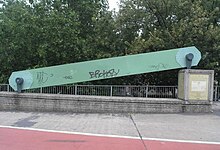Eye stick


An eye stick ( English eyebar ) is a metal rod, the mostly widened flat ends of which each contain an eye , i.e. a round opening to accommodate the bolt that connects to the next eye stick or to attach it to another component.
Eye bars were used as chain links , especially in chain bridges . Later they formed an important part of the North American half-timbered constructions , where the bars and tension belts , which were only subjected to tension but never to pressure, were made from eye bars. Even today, eye sticks are still used on the chain bridges that have become rare. In mechanical engineering and steel construction, eye bar bolt connections are used today when the connection is to be rotatable or to be released frequently and easily. For this purpose, the effects of the influencing variables of the shape of the eye rod, nominal voltage, bolt play, coefficient of friction and enlargement of the head cavity on the load-bearing behavior of the eye rod-bolt connections must be investigated by calculation.
The eye rod is usually made of flat steel , previously flat iron. If several eye rods are used in parallel next to each other or in one component with the same function, they must have the same length and the same modulus of elasticity so that they are loaded in the same way.
The first eye sticks were iron rods, the ends of which were bent up to form loops. It was not only because of the very different material properties of iron at that time that its tensile force could not be foreseen in a satisfactory manner. William Hawks and Samuel Brown developed improved eye rods with perforated or forged eyes between 1805 and 1818. Soon eye sticks made of flat iron and later of steel with a constant, rectangular cross-section were developed, the eyes of which were either forged or formed by upsetting in hydraulic presses. In the USA this was done on an industrial scale. When the Elisabeth Bridge in Budapest was built around 1900, Europe was not or no longer equipped for this production method. Therefore, the chain links were cut in one piece from wide iron lamellas, resulting in a large amount of waste and high manufacturing costs. A similar procedure was followed later when the Deutz suspension bridge was built .
Individual evidence
- ↑ a b c Otto Lueger: Lexicon of the entire technology and its auxiliary sciences . Volume 1, Stuttgart, Leipzig 1904., p. 386 f. On zeno.org
- ↑ Zi-Niu Guo-Geruschkat: Eye stick-bolt connections, taking friction into account. Summary in the bibliography on Baufachinformation.de
- ↑ Tom F. Peters: The development of the large bridge construction . 2nd edition ETH, Zurich 1980. p. 55
Web links
- Eye rod-bolt connections taking friction into account (accessed May 29, 2020)
- Calculation and optimization of bolt-plate connections (accessed May 29, 2020)
- Endurance and fatigue strength of eye rods (accessed May 29, 2020)
- Tension members (accessed May 29, 2020)
- Dimensioning and construction of standardized fasteners for aluminum structures (accessed May 29, 2020)
